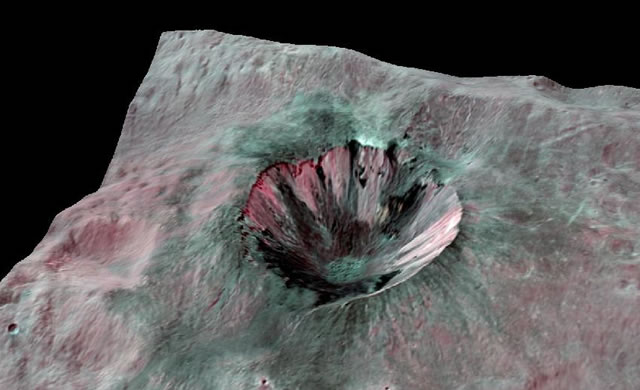
Credits: NASA/JPL-Caltech/UCLA/MPS/DLR/IDA
Vesta, un ospite a sopresa – L’impatto di alcuni asteroidi minori può essere la causa della presenza di materiale scuro e ricco di carbonio sul protopianeta. Lo stesso materiale è presente anche sui meteoriti HED provenienti da Vesta. Lo stesso meccanismo potrebbe aver portato carbonio anche sulla Terra.
Non accennano a esaurirsi le novità in arrivo da Vesta, l’asteroide (o meglio, vero e proprio protopianeta) visitato dalla sonda spaziale della NASA Dawn. Lo scorso settembre quest’ultima ha scattato delle straordinarie immagini di due enormi crateri nell’emisfero sud di quello che è uno degli oggetti più antichi e meglio conservati del sistema solare. In uno studio appena pubblicato sull’ultimo numero della rivista Icarus, Vishnu Reddy e colleghi dimostrano che quei crateri contengono uno scuro materiale carbonaceo che non è “indigeno” ma è stato depositato su Vesta da asteroidi. Il team di ricercatori del Max Plank Institute (Germania) crede che eventi simili, agli albori del nostro Sistema solare, abbiano contribuito all’evoluzione di pianeti come la Terra, portandovi il carbonio che è uno dei mattoni fondamentali della vita.
Fonte/Leggi tutto → Media.Inaf.it
Ever since arriving at Vesta in July 2011, NASA’s Dawn spacecraft has been capturing high-resolution images of the protoplanet’s surface, revealing a surprisingly varied and complex terrain covered in ridges, hills, grooves and, of course, craters of many different sizes and ages.
Many of Vesta’s largest craters exhibit strange dark stains and splotches within and around them, some literally darker than coal. These stains were a puzzle to scientists when they were first seen, but the latest research now confirms that they may actually be the remains of the ancient impacts that caused them: dark deposits left by the myriad of carbon-rich objects that struck Vesta over the past four-and-a-half billion years.
Source/Continue reading → www.universetoday.com





















